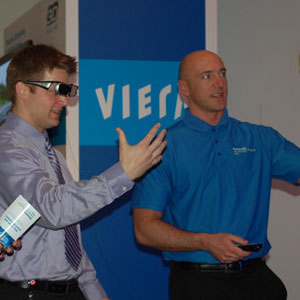Panasonic clears up a few important technical details about 3D.
Several Electronic House contributors have visited the Panasonic Touch the Future Tour over the past couple of weeks, and we’ve each had a different take on what we saw.
Being the staff tech nerd, I latched onto a few important technical details pulled from the tour of Panasonic‘s 2010 model lineup.
Why Active Shutter over Polarized glasses?
One bit of consumer confusion related to 3D comes from the glasses. When you go to see “Clash of the Titans” at a 3D theater or “Muppet Vision 3D” at Disney’s Hollywood Studios, you use cheap plastic glasses with polarized lenses. They’re light weight and cost less than $1 for each pair.
So why are major TV manufacturers gravitating towards heavier and more expensive active shutter glasses?
“Performance,” says Chad, the Panasonic rep on hand. “With an active shutter system, we can close off both eyes for a split second between each frame, which greatly reduces ghosting or crosstalk”.
Crosstalk is a phenomenon where an image intended for one eye is seen by the other, causing ghost images to appear. The Panasonic rep says active shutter glasses make it much easier to eliminate crosstalk compared to passive glasses where a polarized filter on the display has to switch directions for each eye.
Why plasma instead of LCD?
Another big point of consumer confusion rests in the battle between LCD and plasma. Each has its own benefits and drawbacks. Unfortunately, those differences are poorly communicated by manufacturers, especially manufacturers that produce both types. While Panasonic does produce both LCDs and plasmas, it draws a line in the sand at 42 inches; everything bigger is plasma and everything smaller is LCD.
But why is plasma particularly conducive for 3D?
“It’s all about refresh rate”, says Chad. “With LCD technology, refresh rates are limited to 120Hz or 240Hz. With Plasma, we refresh at 600Hz and greatly improve motion perception, especially with 3D content”.
While Full HD 3D maintains full resolution for each eye, refresh rate is effectively cut in half. So a 120Hz LCD offers 60Hz to each eye; a 240Hz display offers 120Hz to each eye; and Panasonic’s 600Hz plasma effectively refreshes at 300Hz for each eye.
What about 3D gaming on the big screen?
Panasonic has partnered with NVIDIA for the Touch the Future Tour. NVIDIA has been a player in 3D for some time with its 3D Vision add-on kit for 3D gaming.
“In the past, we’ve relied on 3D-capable monitors for 3D PC gaming through 3D Vision,” says Rambo Jacoby, marketing manager for NVIDIA. “Now, with our new 3DTV Play software, gamers can connect directly to 3D-capable TVs, without the need for the 3D Vision kit, using the display’s own 3D syncing and glasses.”
I checked out the Avatar PC game in 3D on a 50-inch Panasonic V25 series plasma, and I was very impressed with the effect. That said, afterwards I saw an 11-year-old playing the game with no glasses enjoying it just as much. If kids are a major market focus for NVIDIA’s 3D gaming push, they may want to reflect on how to make the improvements clear to a less critical audience.
The Panasonic Touch the Future Tour is a great event for mall-goers. If you haven’t visited yet, there are only a couple of dates and locations remaining.
This kind of event is exactly what manufacturers need to put their muscle behind to develop consumer interest in 3D and related technologies. Informed answers and hands on demos go a long way, and what I saw and heard was far more informative than any in-store demo I’ve seen to date.
by Stephen Hopkins
http://www.electronichouse.com/article/3d_faqs_from_panasonic_touch_the_future_tour/
Custom Installation Services, LLC – Charlotte and Asheville NC’s Source For Your Custom Home Electronics and Automation Needs!




